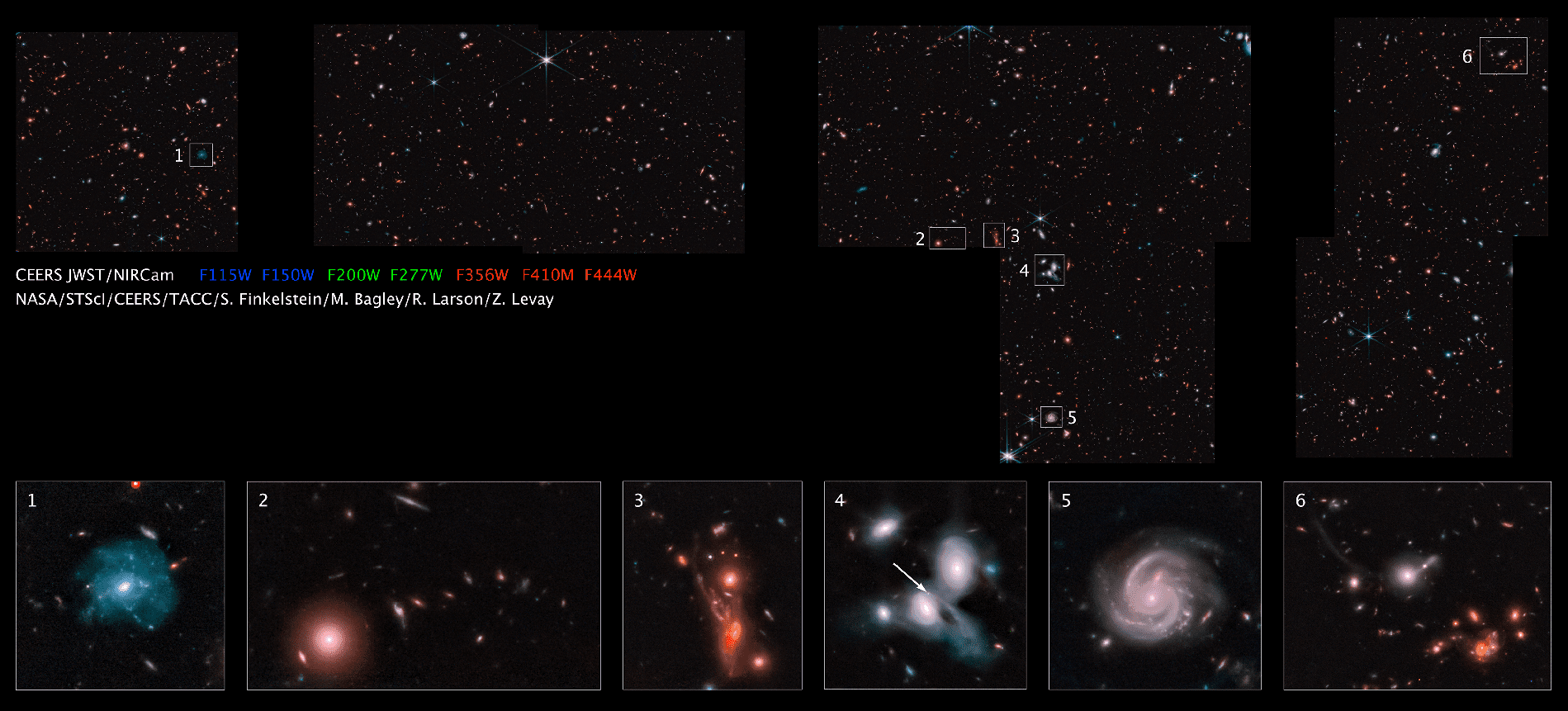An image filled with galaxies was chosen as the first to be released from JWST because it demonstrated the space telescope’s capacities so well. That, however, was just a taster. With more time for light collection, JWST is growing further into its power, as demonstrated by its latest release, part of the Cosmic Evolution Early Release Science Survey (CEERS).
CEERS will focus on galaxies visible in a 100 square arcminutes area of the sky – equal to a seventh of the area of the full Moon, but eight times as large as was covered in that famous first image. The area chosen is one that has already been studied in depth by the Hubble Telescope for the Cosmic Assembly Near-Infrared Deep Extragalactic Legacy Survey (CANDELS). Since the two space telescopes operate at overlapping but different wavelengths, their observations are complementary, rather than the JWST simply making Hubble obsolete, and can be used to calibrate the JWST.
CEERS’ goal is to find ways the JWST can be used efficiently to explore the early universe in parallel with pre-existing observations. It will investigate the emergence of the first galaxies, those with redshifts greater than 7. It will produce spectroscopic samples of many of these galaxies seen from close to the dawn of time, while also measuring the abundance of galaxies with redshifts between 9 and 13. CEERS will also look at the evolution of more recent galaxies, those with redshifts between 1 and 7, for example looking at black hole growth for redshifts greater than 3.
The CEERS Epoch 1 (above) is the largest image yet released by the JWST. Six relatively close and bright galaxies are shown in higher magnification. Image Credit: NASA/STSci/CEERS/TACC/S.Finkelstein/M. Bagley/R. Larson/Z. Levay
The above is a low-res version on the field, with some of the particularly impressive galaxies zoomed in on. Medium and high resolution versions are available from the CEERS homepage, although be warned: Many years ago IFLScience posted a link to NASA’s 1.5 billion pixel zoomable image of the Andromeda Galaxy, taken using Hubble. Shortly after, the site crashed, apparently from excess traffic, and we’ve never known if it was our fault.
The zoomed-in regions of the image above are mostly too close to be part of CEERS main goal, but certainly demonstrate the JWST’s powers. They include:
1. A spiral galaxy at a redshift of 0.16, practically a neighbor compared to the rest of the field, with star-forming regions visible.
2. A chance alignment of a bright galaxy at a 1.05 redshift with several smaller galaxies forming an arc.
3. An interacting system of galaxies at 1.4 redshift, dubbed the “Space Kraken” by the CEERS team.
4. Two interacting spiral galaxies at redshift z=0.7. The arrow points to a supernovae discovered with these JWST images.
5. Another spiral galaxy, also at z = 0.7
6. A chance alignment of a z = 0.63 galaxy with a tidal tail, and a grouping of red galaxies at z = 1.85
JWST has given a major bump to the normally slow process of converting astronomical observations into papers. Already the CEERS team have submitted five papers to peer-reviewed journals based on this photo. One of them has the title “A Long Time Ago In a Galaxy Far, Far Away.” What it lacks in originality it makes up for in accuracy.
The galaxy under discussion has a redshift of 14, and has already achieved some fame under the name “Masie’s Galaxy,” thanks to having been discovered on the birthday of first author Steve Finkelstein’s daughter Maisie. The field also includes CEERS-1749, the Shrodinger’s Galaxy Candidate that is either the most distant ever found or an imposter.
Source Link: JWST's Biggest Image Yet Shows A Field Of Early Galaxies
